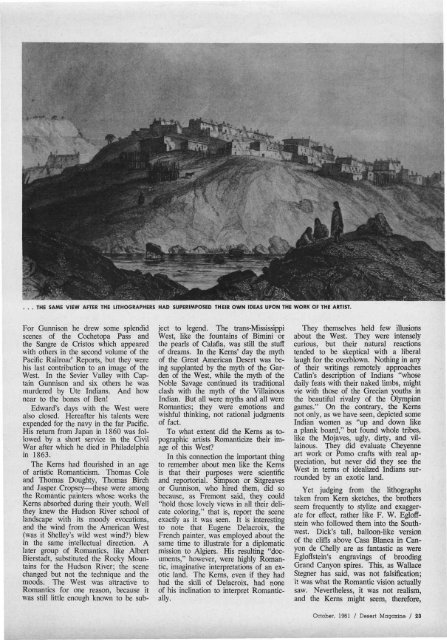OUTDOOR SOUTHWEST - Desert Magazine of the Southwest
OUTDOOR SOUTHWEST - Desert Magazine of the Southwest
OUTDOOR SOUTHWEST - Desert Magazine of the Southwest
You also want an ePaper? Increase the reach of your titles
YUMPU automatically turns print PDFs into web optimized ePapers that Google loves.
•••-•.<br />
... THE SAME VIEW AFTER THE LITHOGRAPHERS HAD SUPERIMPOSED THEIR OWN IDEAS UPON THE WORK OF THE ARTIST.<br />
For Gunnison he drew some splendid<br />
scenes <strong>of</strong> <strong>the</strong> Cochetopa Pass and<br />
<strong>the</strong> Sangre de Cristos which appeared<br />
with o<strong>the</strong>rs in <strong>the</strong> second volume <strong>of</strong> <strong>the</strong><br />
Pacific Railroar 1 Reports, but <strong>the</strong>y were<br />
his last contribution to an image <strong>of</strong> <strong>the</strong><br />
West. In <strong>the</strong> Sevier Valley with Captain<br />
Gunnison and six o<strong>the</strong>rs he was<br />
murdered by Ute Indians. And how<br />
near to <strong>the</strong> bones <strong>of</strong> Ben!<br />
Edward's days with <strong>the</strong> West were<br />
also closed. Hereafter his talents were<br />
expended for <strong>the</strong> navy in <strong>the</strong> far Pacific.<br />
His return from Japan in 1860 was followed<br />
by a short service in <strong>the</strong> Civil<br />
War after which he died in Philadelphia<br />
in 1863.<br />
The Kerns had flourished in an age<br />
<strong>of</strong> artistic Romanticism. Thomas Cole<br />
and Thomas Doughty, Thomas Birch<br />
and Jasper. Cropsey—<strong>the</strong>se were among<br />
<strong>the</strong> Romantic painters whose works <strong>the</strong><br />
Kerns absorbed during <strong>the</strong>ir youth. Well<br />
<strong>the</strong>y knew <strong>the</strong> Hudson River school <strong>of</strong><br />
landscape with its moody evocations,<br />
and <strong>the</strong> wind from <strong>the</strong> American West<br />
(was it Shelley's wild west wind?) blew<br />
in <strong>the</strong> same intellectual direction. A<br />
later group <strong>of</strong> Romantics, like Albert<br />
Bierstadt, substituted <strong>the</strong> Rocky Mountains<br />
for <strong>the</strong> Hudson River; <strong>the</strong> scene<br />
changed but not <strong>the</strong> technique and <strong>the</strong><br />
moods. The West was attractive to<br />
Romantics for one reason, because it<br />
was still little enough known to be sub-<br />
ject to legend. The trans-Mississippi<br />
West, like <strong>the</strong> fountains <strong>of</strong> Bimini or<br />
<strong>the</strong> pearls <strong>of</strong> Calafia, was still <strong>the</strong> stuff<br />
<strong>of</strong> dreams. In <strong>the</strong> Kerns' day <strong>the</strong> myth<br />
<strong>of</strong> <strong>the</strong> Great American <strong>Desert</strong> was being<br />
supplanted by <strong>the</strong> myth <strong>of</strong> <strong>the</strong> Garden<br />
<strong>of</strong> <strong>the</strong> West, while <strong>the</strong> myth <strong>of</strong> <strong>the</strong><br />
Noble Savage continued its traditional<br />
clash with <strong>the</strong> myth <strong>of</strong> <strong>the</strong> Villainous<br />
Indian. But all were myths and all were<br />
Romantics; <strong>the</strong>y were emotions and<br />
wishful thinking, not rational judgments<br />
<strong>of</strong> fact.<br />
To what extent did <strong>the</strong> Kerns as topographic<br />
artists Romanticize <strong>the</strong>ir image<br />
<strong>of</strong> this West?<br />
In this connection <strong>the</strong> important thing<br />
to remember about men like <strong>the</strong> Kerns<br />
is that <strong>the</strong>ir purposes were scientific<br />
and reportorial. Simpson or Sitgreaves<br />
or Gunnison, who hired <strong>the</strong>m, did so<br />
because, as Fremont said, <strong>the</strong>y could<br />
"hold those lovely views in all <strong>the</strong>ir delicate<br />
coloring," that is, report <strong>the</strong> scene<br />
exactly as it was seen. It is interesting<br />
to note that Eugene Delacroix, <strong>the</strong><br />
French painter, was employed about <strong>the</strong><br />
same time to illustrate for a diplomatic<br />
mission to Algiers. His resulting "documents,"<br />
however, were highly Romantic,<br />
imaginative interpretations <strong>of</strong> an exotic<br />
land. The Kerns, even if <strong>the</strong>y had<br />
had <strong>the</strong> skill <strong>of</strong> Delacroix, had none<br />
<strong>of</strong> his inclination to interpret Romantically.<br />
They <strong>the</strong>mselves held few illusions<br />
about <strong>the</strong> West. They were intensely<br />
curious, but <strong>the</strong>ir natural reactions<br />
tended to be skeptical with a liberal<br />
laugh for <strong>the</strong> overblown. Nothing in any<br />
<strong>of</strong> <strong>the</strong>ir writings remotely approaches<br />
Catlin's description <strong>of</strong> Indians "whose<br />
daily feats with <strong>the</strong>ir naked limbs, might<br />
vie with those <strong>of</strong> <strong>the</strong> Grecian youths in<br />
<strong>the</strong> beautiful rivalry <strong>of</strong> <strong>the</strong> Olympian<br />
games." On <strong>the</strong> contrary, <strong>the</strong> Kerns<br />
not only, as we have seen, depicted some<br />
Indian women as "up and down like<br />
a plank board," but found whole tribes,<br />
like <strong>the</strong> Mojaves, ugly, dirty, and villainous.<br />
They did evaluate Cheyenne<br />
art work or Pomo crafts with real appreciation,<br />
but never did <strong>the</strong>y see <strong>the</strong><br />
West in terms <strong>of</strong> idealized Indians surrounded<br />
by an exotic land.<br />
Yet judging from <strong>the</strong> lithographs<br />
taken from Kern sketches, <strong>the</strong> bro<strong>the</strong>rs<br />
seem frequently to stylize and exaggerate<br />
for effect, ra<strong>the</strong>r like F. W. Egl<strong>of</strong>fstein<br />
who followed <strong>the</strong>m into <strong>the</strong> <strong>Southwest</strong>.<br />
Dick's tall, balloon-like version<br />
<strong>of</strong> <strong>the</strong> cliffs above Casa Blanca in Canyon<br />
de Chelly are as fantastic as were<br />
Egl<strong>of</strong>fstein's engravings <strong>of</strong> brooding<br />
Grand Canyon spires. This, as Wallace<br />
Stegner has said, was not falsification;<br />
it was what <strong>the</strong> Romantic vision actually<br />
saw. Never<strong>the</strong>less, it was not realism,<br />
and <strong>the</strong> Kerns might seem, <strong>the</strong>refore,<br />
October, 1961 / <strong>Desert</strong> <strong>Magazine</strong> / 23

















